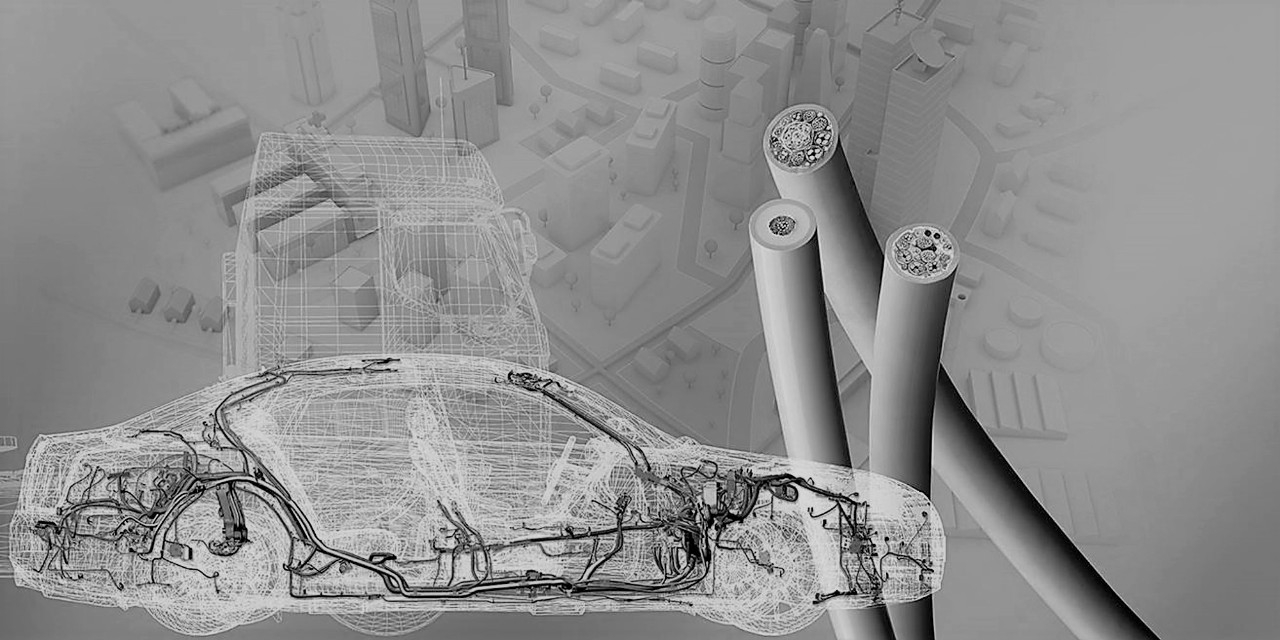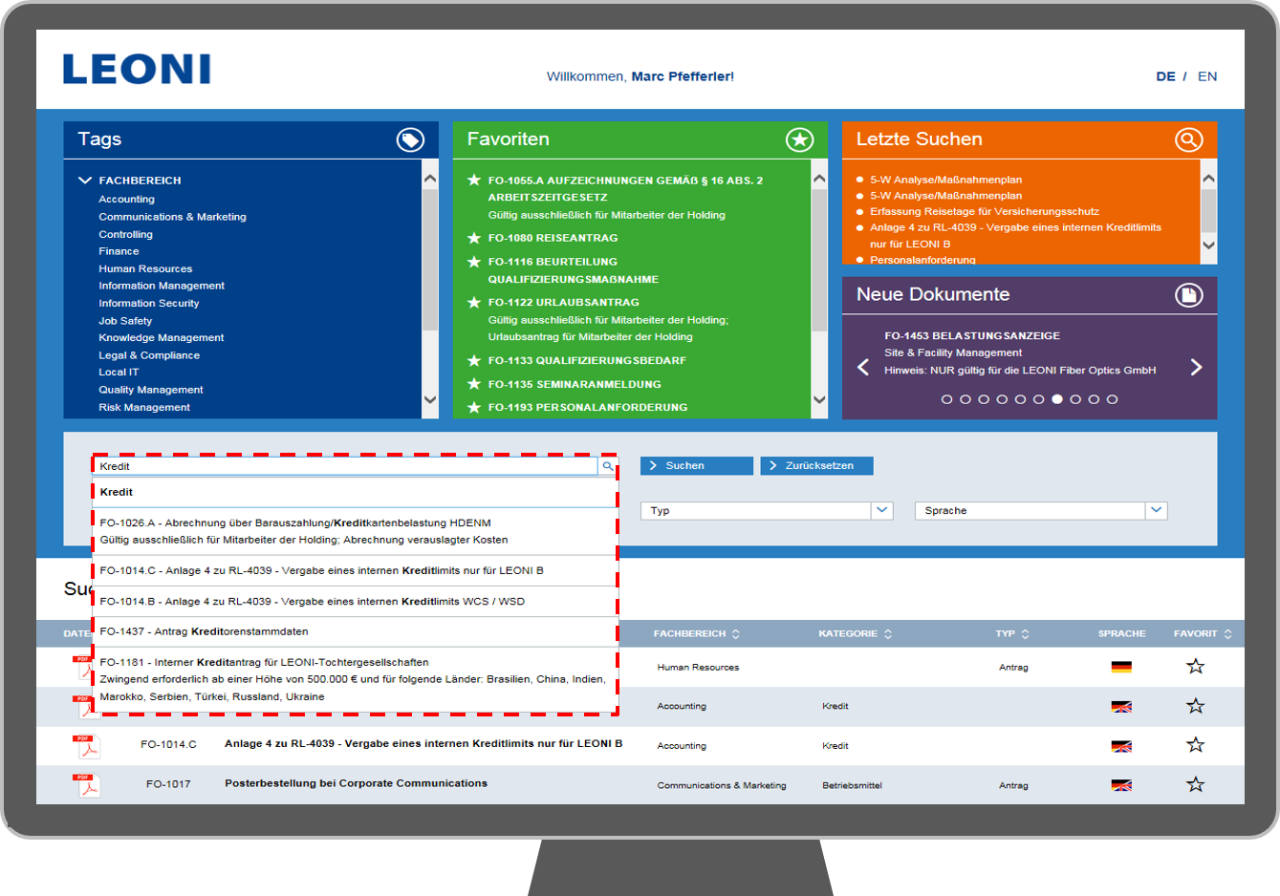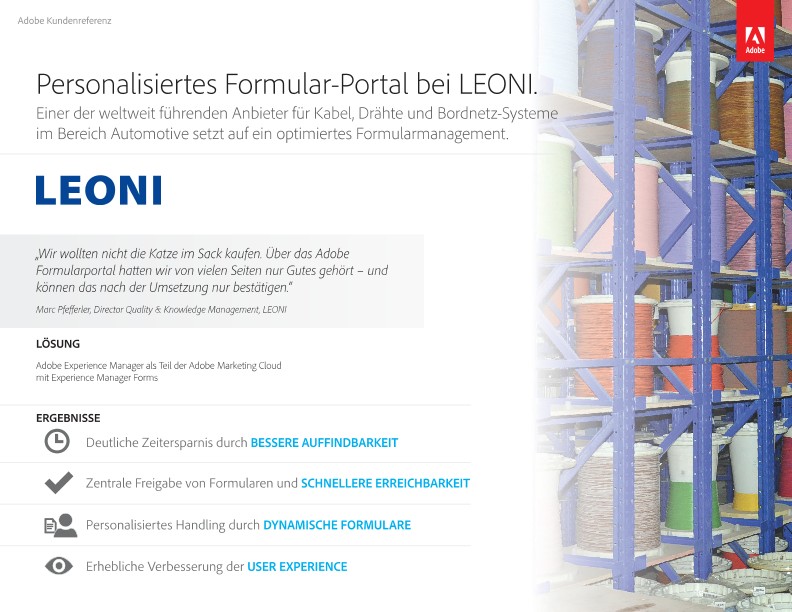
Leoni AG
Case Study
Personalized forms portal at LEONI
One of the world's leading suppliers of cables, wires and automotive electrical systems in the field of automotive technology relies on optimized form management.
"We did not want to take a shot in the dark and rely on uncertainty. Regarding the Adobe Formal Portal, we had only heard good news from many sides - and we can now confirm this after its implementation."
Marc Pfefferler, Director Quality & Knowledge Management, LEONI
Pilot project for the entire company group
As a leading global supplier to the automotive industry for cables, wires and wiring systems, LEONI AG employs more than 76,000 people in 82 subsidiaries worldwide. 92 production sites spread over 32 countries. As a result, structured administrative processes are an important factor in the company's operational organization - from simple holiday request to project forms to compliance-critical approval processes. In the company, the form is the starting point for many processes and it plays an important role here. "It is an essential task to provide intuitive forms, keep them up-to-date, and make them available to employees so they can be easily found," said Marc Pfefferler, Director of Quality & Knowledge Management, The LEONI Holding in Nuremberg. As a pilot project, he has therefore set up their own form portal. Based on Adobe Experience Manager Forms, as part of the Adobe Marketing Cloud, this solution will enable the entire LEONI Group to lead the way.
Consistent user experience and better searchability
Form management at LEONI began with simple Word or Excel documents, which were difficult to protect and secure against unauthorized changes. This resulted in a sometimes annoying back and forth, and so these forms were then converted to PDF, because the Acrobat Reader has long been on every employee’s computer. These PDF forms were printed out, filled out by hand, partially signed and then put into the good old house snail mail. In general, the creation and administration of forms at LEONI was decentralized to the respective departments. Over time, many form standards and designs have been established. The forms themselves were located in the LEONI intranet or on the file systems, stored in the folders of the relevant departments. Finding the required forms in the current version was not always easy. Therefore, the entire form management needed to be placed on a new foundation, which also benefits the users through a uniform user experience and the searchability in a personalized form portal needed to be significantly improved. Form managers also needed to be able to centrally manage the variety of forms and documents, make updates, and make all forms available to employees at a central location. "We also wanted to regulate compliance with form standards with regard to our certification according to the ISO standard 9001: 2015, which placed many new requirements within the framework of quality and knowledge management," says Pfefferler.
Decentralized form creation in the business areas
Since LEONI was already successfully using Adobe creative products, such as InDesign and Photoshop, and we were absolutely able to convince them to engage our services with a presentation of Adobe Experience Manager (AEM) Forms and the decision was made to test this solution. The concrete implementation and adaptation to the specific conditions was carried out by the eggs unimedia experts in Munich. The LEONI employees played an important role in the entire project, because the forms are finally intended for them. Their identified goal was to improve their user-friendliness considerably compared to the past and to make them as self-explanatory as possible. In the past, a large part of the forms are implemented by employees in the field of knowledge management, but in the future, responsible persons are to be added to the individual areas of the company, who will then develop their own forms and make them centrally available via the portal.
Intelligent workflows and dynamic forms lead to time savings
A particular challenge at LEONI was the improvement of the searchability. Because the forms were originally accessible via an intranet page and sorted alphabetically: by title, form number and department. When using the search function, there may have been several hits - and they were not only from the search criteria. The prerequisite for quickly finding what the user wanted to find was therefore an accurate knowledge of the forms. Alternatively, the search was organised by the subject area, but the knowledge about the correct assignment of the form was necessary. These elaborate actions are now a thing of the past with the use of Adobe Experience Forms. Forms can now be tagged immediately when they are uploaded to the portal so that they can be filtered when searching for the respective "tags". For this purpose, a day structure was developed by department (for example, personnel, controlling), by category (for example, continuing education, business trip) and type of form (for example, application, verification). In addition, employees can use a full-text search with Auto-ll function and mark their most important documents as favourites, so they can be displayed in a personalized list in the form portal. This greatly reduces the time needed to find the right form today.
Adaptive forms, which adapt themselves on the display of all conceivable terminals, are not presently in the LEONI’s form management, because the documents are largely worked on the user’s desktop. This extension however, would be possible to implement at any time. Dynamic functions in forms and processes, on the other hand, are already being used. For example, if additional management level approval and signatures are required when a certain project budget has been exceeded. "We have also integrated multilingualism and autocompletion capabilities into many fields to help our employees work more rationally and efficiently when they use the forms," explains Marc Pfefferler. The forms now follow a uniform design and digital signatures are already set up. Thanks to the central filing system, employees are now always able to access the most up-to-date versions of the forms at any time, which in addition to shortening the search time, further reduces the risk of errors and moreover, further increases efficiency.
Challenges
- Central provision of clearly assigned forms in the most current state
- Implementation of largely paperless administrative processes without media discontinuation
- Definition of uniform workflows in form management
- Illustration of the company’s organisational structure in form processes
- Improve user experience through intuitive user guidance

Solution at a glance
Adobe Marketing Cloud with
- Adobe Experience Manager Forms
Results
- Significant time savings through BETTER EFFICIENCY
- Personalized handling by DYNAMIC FORMS
- Central release of forms and FASTER ACCESS
- Significant improvement of the USER EXPERIENCE

